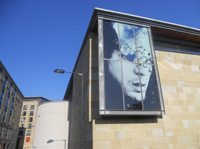

|
| 2. Douglas Gordon 'Self portraitof you and me (blue skies)'
He looks up to see the Gaumont Cinema. The Stones played there, he thinks, along with Eddie Cochrane, Jimi Hendrix, Bo Diddley, Bill Haley, Count Basie, Helen Shapiro, Tom Jones, Cilla Black, The Everley Brothers and the Beatles. The twenty-one year old Barrett puts down the plastic duck from the Floyd stage he realises he is still carrying and trails his hand along the cold wet stones of the 1930’s building.
Douglas Gordon starts playing with fire at Glasgow School of Art in 1987, fields of candles illuminating the sawdust floors during his excruciatingly slow ritualistic performances on the top floor of the old Girls High School. Twenty years later at a former wash-house at Inverleith House in Edinburgh he presents Plato’s Cave, a flame projecting viewers’ shadows onto plastered walls. His recent ‘k.364’ exhibition at the Gagosian includes the key image of a hand gripping a candle, elapsed time evidenced by the solidified wax down the artist’s own left arm, as his right wields the blow torch, burning his candle at one end. As Jonathan Jones notes in the Guardian “The photograph is instantaneous, but the history of pain it communicates is agonising – a process of endurance frozen in one image. An act of witness, too, for the hand holds up a candle, a light to illuminate the darkness.” (i)
In the Summer of 1966, Syd Barrett’s film student friend Nigel Gordon captures him on Super-8 experimenting with mushrooms for the first time. The resulting five-minute film is a remarkable piece of evidence of the turning point in Syd’s life. Syd is seen clambering joyfully up the Gog Magog Hills in Cambridgeshire before laying back under blue skies and placing mushrooms over both his eyes and his mouth. It is spookily reminiscent of Douglas’ Self-portraits of you + me series in which he uses flames to carefully erode eyes, noses and mouths from publicity images of Hollywood or rock stars. The remains are mounted onto reflective surfaces, forcing viewers to have their fleeting moments of fame or see stars reflected in stars reflected in stars.
Douglas wants to see how close he can get to his idols before they burst into flames, burning the mouth of Janis Joplin, the head of Marianne Faithful, the eyes of Johnny Cash, the lips of Mick Jagger, the forehead of Jimi Hendrix, the pretty face of Jayne Mansfield and the twinkling eyes of Sean Connery. He burns our mediated 1960s stars via Andy Warhol prints, the nose of Jackie Onassis, the blonde hair of Marilyn Monroe, the kiss curl of Elvis Presley, the head of Mohammed Ali, the eyebrows of John Wayne and the smile of Elizabeth Taylor. We want him to burn all our images, all those that burn the brightest; Alfred Hitchcock, Paul McCartney, Christine Keeler, Neil Armstrong, Fidel Castro, Bob Dylan, John Lennon, Jane Fonda, Hugh Heffner, John F Kennedy and Douglas Gordon himself.
For Bradford, Douglas’ burnt image of Syd Barrett is carefully mounted onto a mirror, re-photographed against blue skies and mounted in the large windows of Impressions Gallery, directly facing the former Gaumont Cinema. The artist pains at watching someone’s world fall apart, photographing it, mirroring it, perhaps even seeing in it his very own collapse. Hang-dog expression and collar turned up high against the late night winds, he slumps back against the cinema’s wall, staring vacantly at the huge plate glass windows opposite, reflecting him as he burns out.
**************
Alan Dunn is an artist born on 4 August 1967, the day Pink Floyd’s debut album Pipers at the gates of dawn was released. He studied at Glasgow School of Art alongside Douglas Gordon in the second half of the 1980s. Pink Floyd’s ‘Set the controls to the heart of the sun’ was recorded in August 1967. The text references Gordon’s work ‘Afterturner’ based on JMW Turner’s last words (god is the sun, the son is good, god is the son...). One of the bands listed did not actually play at the Gaumont.
|